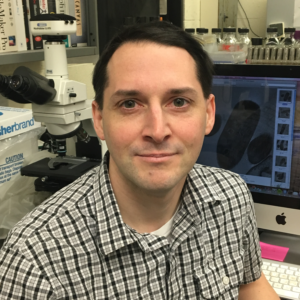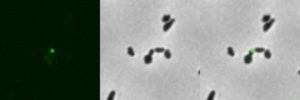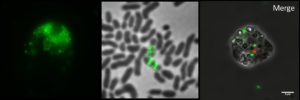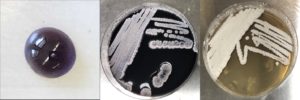Assistant Professor of Biology
Office: Arnett Hall 313Phone: (304) 336-8136E-Mail: stuart.cantlay@westliberty.edu Address:
West Liberty University
208 University Drive
College Union Box 139
West Liberty, WV 26074
Degrees:
- B.A. (Dual Hons) Philiosophy and Economics – University of East Anglia, 1996
- B.Sc. Cell Biology – University of East Anglia, 2003
- Ph.D. Molecular Microbiology – University of East Anglia, 2008
Courses:
- BIO 208 Active Study
- BIO 216 Microbiology for Non Majors
- BIO 325 Microbiology
- BIO 329 / BIO 578 – Applied Microbiology
- BIO 478/ BIO 578 – Nanopore Sequencing
- CLS 360 Clinical Microbiology I
- CLS 415 Molecular Diagnostics
- CLS 416 Molecular Lab
- CLS 490 Research Problems in Clinical Laboratory Science
Current Research Projects:
My research interests center around microbial cell biology.
I am currently investigating the role of two genes thought to be involved in infection and virulence of the intracellular pathogen Francisella tularensis. Using mutagenesis and in vitro invasion assays I am interested in understanding the role of opiA and pdpC, that encode effectors of the type VI secretion system of F. tularensis. I am also using fluorescence microscopy to analyse the localization of OpiA and am interested in the role opiA plays in growth and viability of Francisella.
I am also conducting research looking into the morphological and physiological changes that occur in F. tularensis cells over time. Specifically, we are using a variety of molecular techniques to analyse the effect these changes have on virulence and persistence of Francisella. A critical part of this research is understanding the molecular mechanisms that underpin the changes we observe. To do this we are investigating the function of proteins that are involved in cell shape and viability and are interested in discovering new genes and factors which affect cell shape and viability.
In addition to the work on F. tularensis, my first passion for microbiology was the molecular microbiology of Streptomycetes. These fascinating soil microbes are important for agriculture and are the chemical factories from which a large proportion of antibiotics and other biologically active compounds are derived. I hope to develop my research to include the study of signaling pathways in two model Streptomycetes, Streptomyces venezuelae and Streptomyces ceolicolor and to assess the role of these pathways in growth and antibiotic production.
Finally, as part of my role teaching Applied Microbiology at West Liberty I am trying to develop a program to assess and monitor the water quality of local waterways. Working with other members of faculty in the Biology Department we are using EPA approved methodologies to estimate enteric and coliform bacteria present in local streams. Students taking the Applied Microbiology course are directly involved in sampling and analyzing water quality and in isolating and characterising microbial species present in our waterways. In particular, we are focused on looking for indicators of fecal bacteria which may pose a public health risk. In collaboration with researchers from Pittsburgh, we are also able to characterise and record the chemical properties of the water at our sampling locations. The wider goal is to generate a record of water quality in the region which can be used to help inform public health decisions and environmental policy.
Publications:
Cantlay, S, Kaftanic C, Horzempa, J. PdpC, a secreted effector protein of the type six secretion system, is required for erythrocyte invasion by Francisella tularensis LVS. Front Cell Infect Microbiol. 2022 Sept 27; 12:979693. doj: 10.3389/fcimb.2022.979693.
Passot FM, Cantlay S, Flärdh K. Protein phosphatase SppA regulates apical growth and dephosphorylates cell polarity determinant DivIVA in Streptomyces coelicolor [published online ahead of print, 2021 Dec 4]. Mol Microbiol. 2021;10.1111/mmi.14856. doi:10.1111/mmi.14856
Collins E, Martin C, Blomquist T, Phillips K, Cantlay S, Fisher N, Horzempa J. The utilization of Blaptica dubia cockroaches as an in vivo model to test antibiotic efficacy. Sci Rep. 2021;11(1):24004. Published 2021 Dec 14. doi:10.1038/s41598-021-03486-3
Stuart Cantlay, Beer Chakra Sen, Klas Flärdh and Joseph R. McCormick “Influence of core divisome proteins on cell division in Streptomyces venezuelae ATCC 10712″ Microbiology, Volume 167, Issue 2. Published 05 January 2021 https://doi.org/10.1099/mic.0.001015
Cantlay S, Haggerty K, Horzempa J. OpiA, a Type Six Secretion System Substrate, Localizes to the Cell Pole and Plays a Role in Bacterial Growth and Viability in Francisella tularensis LVS. J Bacteriol. 2020 Jun 25;202(14):e00048-20. doi: 10.1128/JB.00048-20. PMID: 32366588; PMCID: PMC7317039.
Santos-Beneit F, Roberts DM, Cantlay S, McCormick JR, Errington J. A mechanism for FtsZ-independent proliferation in Streptomyces. Nat Commun. 2017;8(1):1378. Published 2017 Nov 9.
Fuchino K, Bagchi S, Cantlay S, et al. Dynamic gradients of an intermediate filament-like cytoskeleton are recruited by a polarity landmark during apical growth. Proc Natl Acad Sci U S A. 2013;110(21):E1889–E1897.
Hempel AM, Cantlay S, Molle V, et al. The Ser/Thr protein kinase AfsK regulates polar growth and hyphal branching in the filamentous bacteria Streptomyces. Proc Natl Acad Sci U S A. 2012;109(35):E2371–E2379.
Wang S, Cantlay S, Nordberg N, Letek M, Gil J. A., and Flärdh K. (2009), Domains involved in the in vivo function and oligomerization of apical growth determinant DivIVA in Streptomyces coelicolor. FEMS Microbiology Letters, 297: 101-109.
Interests and Hobbies:
I enjoy running and I like visiting new places with my family. As a transplant to the US, it is my dream to take road trips to every state (so far I have been to 8…)



